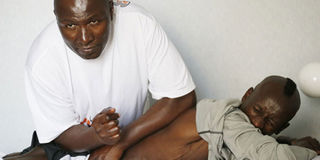Step-by-step home remedy for a muscle strain

Olympic and world 3000m steeplechase champion Ezekiel Kemboi gets a deep muscle massage from physiotherapist Japheth Karakim at the team's Cosmos Hotel in Moscow on August 13 2013. A muscle strain also referred to as muscle pull, is an injury to muscle due to strenuous activity. Such activity includes quick or heavy lifting, and various other sporting activities. PHOTO | FILE |
What you need to know:
- A muscle strain also referred to as muscle pull, is an injury to muscle due to strenuous activity. Such activity includes quick or heavy lifting, and various other sporting activities
- Muscle strain causes varying degrees of injury to the tiny blood vessels. To manage local bleeding or swelling, keep the strained muscle in a stretched, relaxed position and apply ice packs or cold compressors
A muscle strain also referred to as muscle pull, is an injury to muscle due to strenuous activity. Such activity includes quick or heavy lifting, and various other sporting activities.
If the strain is severe, it can cause tearing of the muscle, which can also damage blood vessels.
A muscle strain is characterised by swelling, redness or bruising, and pain when one uses the specific muscle or the joint related to the injured muscle. All this will result in inability to use the injured muscle.
Muscle strain causes varying degrees of injury to the tiny blood vessels. To manage local bleeding or swelling, keep the strained muscle in a stretched, relaxed position and apply ice packs or cold compressors.
These limit the degree of inflammation. Heat may be applied to further relax the muscle, but this should only be done after 24 hours to prevent an increase in pain and swelling.
TIPS FOR MANAGING STRAINS
First aid for muscle strain involves rest, ice, compression, and elevation of the injured area. The acronym RICE will help you to remember this. Here is how to do it;
First: Remove any constrictive clothing or jewellery from the affected area.
Second: Rest and avoid activities that can cause further tearing.
Third: Apply an Ice pack or cold compress on the area for 15 minutes every two hours, for 24 hours. Applying an ice pack may help reduce inflammation of the injured area.
Fourth: Compress the injured area gently, using an elastic bandage or a clean piece of cloth that extends well beyond the injured part. Wrap just tightly enough to avoid constricting circulation.
A compression provides support to prevent further injury and reduces swelling.
Fifth: Place the injured area in an elevated position to reduce swelling. For example, you can raise a strained leg muscle while sitting.
Sixth: Take a pain reliever, such as ibuprofen, to reduce pain.
HOW TO AVOID STRAINS
These steps should help to correct the strained muscle within a few days. If the pain is severe and does not go away after a reasonable period, then it is advisable to see a doctor.
Though muscle strain is bound to happen as we go about our daily activities, there are a few steps you can take to keep them at bay.
Stay active: Poor physical conditioning is a major cause of muscle strain. If you have been inactive for a prolonged period, you increase your risk of getting a muscle strain, even from everyday activities.
Go slow: When exercising or engaging in intense physical activity, begin slowly and build up muscle strength as you progress. Do stretching exercises prior to any strenuous physical activity for at least five to 10 minutes while concentrating on areas that are susceptible to muscle strain, such as lower back, calves, and groin. Stop the activity if you feel too tired or if your muscles begin to get sore.
Treat yourself gently: Take care of any part of your body that has been previously injured by using a bandage or tape to support it, even when it feels as if it has healed, to minimise chances of re-injury.




